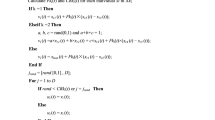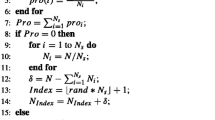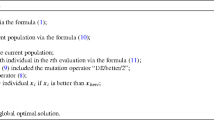Abstract
Although the Differential Evolution (DE) algorithm has been shown to be a simple yet powerful evolutionary algorithm for optimizing continuous functions, users are still faced with the problem of preliminary testing and hand-tuning of the evolutionary parameters prior to commencing the actual optimization process. As a solution, self-adaptation has been found to be highly beneficial in automatically and dynamically adjusting evolutionary parameters such as crossover rates and mutation rates. In this paper, we present a first attempt at self-adapting the population size parameter in addition to self-adapting crossover and mutation rates. Firstly, our main objective is to demonstrate the feasibility of self-adapting the population size parameter in DE. Using De Jong's F1–F5 benchmark test problems, we showed that DE with self-adaptive populations produced highly competitive results compared to a conventional DE algorithm with static populations. In addition to reducing the number of parameters used in DE, the proposed algorithm actually outperformed the conventional DE algorithm for one of the test problems. It was also found that that an absolute encoding methodology for self-adapting population size in DE produced results with greater optimization reliability compared to a relative encoding methodology.
Similar content being viewed by others
References
Abbass HA (2002) The self-adaptive Pareto differential evolution algorithm. In: Proceedings of the 2002 congress on evolutionary computation, vol 1, IEEE Press, Piscataway, NJ, pp 831–836
Arabas J, Michalewicz Z, Mulawka J (1994) GAVaPS – a genetic algorithm with varying population Size. In: Proceedings of the 1st IEEE conference on evolutionary computation, IEEE Press, Piscataway, NJ, pp 73–78
De Jong KA (1975) An analysis of the behaviour of a class of genetic adaptive systems. PhD Thesis, Univesity of Michigan
Eiben AE, Hinterding R, Michalewicz Z (1999) Parameter control in evolutionary algorithms. IEEE Trans Evol Comput 3(2):124–141
Fernandes C, Rosa A (2001) A study on non-random mating and varying population size in genetic algorithms using a royal road function. In: Proceedings of the 2001 congress on evolutionary computation, IEEE Press, Piscataway, NJ, pp 60–66
Goldberg DE, Deb K, Clark JH (1992) Accounting for noise in the sizing of populations. In: Whitley LD Ed. Foundations of genetic algroithms, vol 2, Morgan Kaufmann, San Mateo, CA, pp 127–140
Goldberg DE, Deb K, Korb B (1992) Genetic algorithms, noise, and the sizing of populations. Complex Syst 6:333-362
Harik GR, Lobo FG (1999) A parameter-less genetic algorithm. In: Banzhaf W, Daida J, Eiben AE, Garzon MH, Honavar V, Jakiela M, Smith RE Eds. Proceedings of the 1999 genetic and evolutionary computation conference, vol 1, Morgan Kaufmann, Orlando, Florida, pp 258–265
Hinterding R (1995) Gaussian mutation and self-adaptation in numeric genetic algorithms. In: Proceedings of the 2nd IEEE conference on evolutionary computation, IEEE Press, Piscataway, NJ, pp 384–389
Julstrom BA (1995) What have you done for me lately? adapting operator probabilities in a steady-state genetic algorithm. In: Eshelman L Ed, Proceedings of the 6th international conference on genetic algorithms, Morgan Kaufmann, San Mateo, CA, pp 81–87
Lis J (1996) Parallel genetic algorithm with dynamic control parameter. In: Proceedings of the 3rd IEEE conference on evolutionary computation, IEEE Press, Piscataway, NJ, pp 324–329
Lobo FG, Goldberg DE (2001) The parameter-less genetic algorithm in practice. Technical Report 2001022, University of Illinois at Urbana-Champaign, Urbana, IL
Sarker R, Kazi MFA (2003) Population size search space and quality of solution: An experimental study. In: Proceedings of the 2003 congress on evolutionary computation (CEC2003), vol 3, IEEE Press, Piscataway, NJ, pp 2011–2018
Schlierkamp-Voosen D, Muhlenbein H (1994) Strategy adaptation by competing subpopulations. In: Davidor Y, Schwefel H-P, Manner R Eds. Proceedings of the 3rd conference of parallel problem solving from nature, no 866, Lecture notes in computer science, Springer, Berlin Heidelberg NewYork, pp 199-208
Shi XH, Wan LM, Lee HP, Yang XW, Wang LM, Liang YC (2003) An improved genetic algorithm with variable population size and a pso-ga based hybrid evolutionary algorithm. In: Proceedings of the 2nd international conference on machine learning and cybernetics, IEEE Press, Pistacaway, NJ, pp 1735–1740
Smith R (1997) Population Size. In: Back T, Fogel D, Michalewicz Z Eds. Handbook of evolutionary computation, Chapter E1.1, Oxford University Press, New York, pp 1–5
Spears WM, De Jong KA, Back T, Fogel DB, de Garis H (1993) An overview of evolutionary computation. In: Brazdil PB, Ed. Proceedings of the 1993 European conference on machine learning, vol 667, Vienna, Austria, Springer, Berlin Heidelberg New York, pp 442–459
Spears WM (1995) Adapting crossover in evolutionary algorithms. In: McDonnell JR, Reynolds RG, Fogel DB Eds. Proceedings of the 4th Annual conference on evolutionary programming, MIT Press, Cambridge, MA, pp 367–384
Storn R, Price K (1995) Differential evolution: a simple and efficient adaptive scheme for global optimization over continuous spaces. Technical Report TR-95-012, International Computer Science Institute, Berkeley
Tan KC, Lee TH, Khor EF (2001) Evolutionary algorithms with dynamic population size and local exploration for multiobjective optimization. IEEE Trans Evol Comput 5(6):565–588
Teo J, Abbass HA (2003) Elucidating the benefits of a self-adaptive Pareto EMO approach for evolving legged locomotion in artificial creatures. In: Proceedings of the 2003 IEEE conference on evolutionary computation, vol 2, IEEE Press, Pistacaway, NJ, 2:755–762
Yao X (2002) Evolutionary computation: A gentle introduction. In: Sarker R, Mohammadian M, Yao X, Eds. Evolutionary optimization, Kluwer, New York, pp 27–53
Zhuang N, Benten MS, Cheung PY (1996) Improved variable ordering of BDDS with novel genetic algorithm. In: Proceedings of the IEEE International Symposium on Circuits and Systems, vol 3, IEEE Press, Piscataway, NJ, pp 414–417
Author information
Authors and Affiliations
Corresponding author
Rights and permissions
About this article
Cite this article
Teo, J. Exploring dynamic self-adaptive populations in differential evolution. Soft Comput 10, 673–686 (2006). https://doi.org/10.1007/s00500-005-0537-1
Published:
Issue Date:
DOI: https://doi.org/10.1007/s00500-005-0537-1




